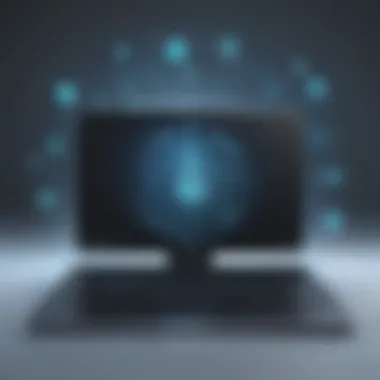Effective Methods to Remove Malware from Your Computer at No Cost


Overview of Cyber Security Threats
In a digital landscape fraught with cybersecurity perils, it is crucial to understand the diverse range of cyber threats menacing our online existence. Malware, phishing, and ransomware are but a few of the insidious tools wielded by malicious actors to infiltrate systems and steal sensitive information. The prevalence of cyber attacks is startling, with statistics indicating a sharp rise in data breaches and security compromises. Real-life examples serve as poignant reminders of the devastating consequences of lax digital defenses, highlighting the urgent need for robust protective measures.
Best Practices for Online Security
The foundation of resilient cyber security lies in the implementation of best practices that fortify our digital fortresses against malicious incursions. Crafting strong, complex passwords and diligently managing them is the first line of defense against unauthorized access. Regular software updates and patches are crucial in plugging security vulnerabilities to thwart potential exploits. Embracing two-factor authentication adds an extra layer of protection, acting as a formidable barrier against unauthorized entry.
Reviews of Security Tools
Navigating the myriad security tools available can be a daunting task, necessitating a judicious evaluation of their effectiveness. Assessing the efficacy of antivirus software is paramount in shielding against malware threats, while comparing firewall protections aids in fortifying network defenses. An appraisal of password managers illuminates their role in securely storing and managing sensitive login credentials, contributing to a robust security posture.
Tips for Ensuring Online Privacy
Preserving online privacy is contingent upon a series of proactive measures aimed at safeguarding personal information in the digital realm. Leveraging VPNs for secure browsing encrypts online communication, shielding user data from prying eyes. Tending to privacy settings on social media platforms is essential to control the dissemination of personal information. Safeguarding personal data during online transactions involves exercising caution and employing secure payment methods to prevent unauthorized access.
Educational Resources and Guides
Equipping oneself with the requisite knowledge to bolster online security is imperative in navigating the treacherous cyberspace effectively. Accessing how-to articles on setting up encryption tools empowers users to encrypt sensitive data, rendering it indecipherable to unauthorized entities. Step-by-step guides on identifying and combatting phishing emails serve as invaluable resources in thwarting social engineering attacks. Additionally, cheat sheets offering quick and actionable insights aid individuals in fortifying their online security practices with ease and efficacy.
Understanding Malware
In this section, we delve into the critical topic of Understanding Malware, which serves as the cornerstone of this comprehensive guide on how to eradicate malware from your computer without incurring any costs. Understanding the nature of malware is paramount in safeguarding your device against potential cyber threats. By identifying and comprehending the different types of malicious software, users can better equip themselves to tackle these issues effectively. This section will explore the intricacies of malware, its behavior, and the impact it can have on a system's security.
Types of Malware
Viruses
Viruses are known for their ability to replicate and spread rapidly within a system, causing considerable damage along the way. Their unique characteristic lies in their ability to attach themselves to legitimate files, executing malicious actions without the user's knowledge. Viruses remain a prevalent choice for cyber attackers due to their disruptive nature and the challenges they pose in detection and removal.
Worms


Worms differ from viruses in that they are standalone programs capable of self-replicating and spreading across networks independently. Their key feature is their ability to exploit network vulnerabilities, allowing them to infiltrate systems seamlessly. While worms can propagate rapidly, their self-sufficiency makes them a formidable malware threat in the cyber landscape.
Trojans
Trojans masquerade as legitimate software to deceive users, gaining access to sensitive information or causing harm once executed. Their hallmark characteristic is their deceptive nature, enticing users to unwittingly install malicious programs. Trojans capitalize on social engineering tactics to infiltrate systems, making them a prevalent choice for cybercriminals seeking to exploit user trust.
Ransomware
Ransomware encrypts a user's files, holding them captive until a ransom is paid for their release. This type of malware thrives on extortion and unpredictability, instilling fear and coercing users into compliance. Its unique feature lies in its direct impact on users, compromising their data integrity and privacy for financial gain.
Impact of Malware
Data Theft
Malware-induced data theft poses a severe threat to user privacy and security by compromising sensitive information and confidential data. Cybercriminals exploit this breach to commit fraudulent activities or identity theft, leading to substantial financial and reputational losses for victims. The intricacies of data theft underscore the critical need for robust cybersecurity measures to mitigate such risks effectively.
System Slowdown
Malware-induced system slowdowns result in decreased operational efficiency and performance degradation, impacting user experience and productivity. The key characteristic of system slowdowns lies in their subtle yet pervasive nature, often evading detection until significant damage is incurred. Understanding the implications of system slowdowns empowers users to take proactive measures to prevent and combat such disruptions effectively.
Privacy Breach
Privacy breaches orchestrated by malware jeopardize user confidentiality and expose sensitive information to unauthorized parties. The hallmark characteristic of privacy breaches is their violation of personal data integrity, leading to concerns regarding identity theft and invasive surveillance. Addressing privacy breaches requires enhanced security measures and vigilance to protect user privacy rights and prevent detrimental consequences.
Identifying Malware Symptoms
Identifying malware symptoms is a critical aspect when it comes to ensuring the security and optimal performance of your computer. By being able to recognize the signs of a potential malware infection, you can take necessary actions to safeguard your device from cyber threats. This section will highlight key symptoms to look out for and their significance in the context of malware removal.
Unusual Pop-Ups
Unusual pop-ups on your computer screen can indicate a malware infection. These pop-ups may appear out of nowhere, promoting questionable products or displaying alarming messages. Clicking on these pop-ups can lead to further malware infiltration or data compromise. It is essential to address such pop-ups promptly to prevent any potential harm to your system and personal information.
Decreased Performance


Another common symptom of malware presence is a noticeable decline in your computer's performance. If you experience sudden slowness, frequent freezes, or delays in executing commands, there might be malware affecting your system. Malicious software consumes computing resources, resulting in performance issues. Addressing decreased performance can help in identifying and eliminating malware effectively.
Strange Behavior
Unexplained changes in your computer's behavior, such as programs launching on their own, files disappearing, or settings being altered without your consent, could indicate a malware infection. Malware often manipulates system settings and initiates unauthorized actions. Understanding and recognizing these unusual behaviors are crucial steps in combating malware and protecting your device from further harm.
Free Methods to Remove Malware
The segment on Free Methods to Remove Malware is crucial within the broader context of combating cyber threats. In this article, we delve deep into the realm of eliminating malware from your system without incurring any financial costs. By exploring free methods, individuals can enhance the security and efficiency of their devices, effectively thwarting potential cyber intrusions. It is imperative to highlight the significance of utilizing cost-free solutions in ensuring the protection and smooth operation of your computer.
Using Antivirus Software
Scanning Your System
Scanning Your System proves to be a fundamental element in the process of combating malware. By conducting thorough scans, users can detect and eliminate malicious software from their computers effectively. The key advantage of scanning is its ability to pinpoint hidden threats, ensuring a comprehensive cleansing of the system. Scanning is a popular choice due to its efficiency in identifying and isolating malware, thereby safeguarding the device from potential harm. While scanning enhances security, it may consume time and system resources during the process, presenting a minor drawback in this article's context.
Quarantining Malware
Quarantining Malware involves isolating malicious files to prevent them from causing further harm to the system. This proactive approach aids in neutralizing the threat posed by malware, protecting the integrity of the device. The key characteristic of this method lies in its ability to contain infections, preventing them from spreading and causing extensive damage. Although effective in limiting malware activity, quarantining may lead to false positives, impacting legitimate files and applications.
Removing Infected Files
The process of Removing Infected Files is instrumental in eradicating malware from the system. By deleting identified malicious files, users can purge their devices of harmful software, restoring optimal functionality. The unique feature of this method is its direct approach towards eliminating threats, ensuring a clean system free of malware. While effective, removing infected files may result in unintentional deletion of essential data if performed erroneously, warranting caution during the execution.
Utilizing Windows Defender
Performing a Full System Scan
Performing a Full System Scan using Windows Defender enhances the overall security of the computer. This comprehensive scan thoroughly examines all files and applications, identifying and resolving potential security issues. The key characteristic of this feature is its thoroughness in detecting both known and emerging threats, offering robust protection. Despite its effectiveness, performing a full system scan may prolong the scanning process, impacting system performance temporarily.
Updating Definitions
Updating Definitions ensures that Windows Defender remains equipped to combat evolving malware threats effectively. By staying up-to-date with the latest definitions, the antivirus software can recognize new variants of malware, bolstering the system's defenses. The unique feature of updating definitions is its proactive nature in preempting emerging threats, enhancing the security posture. However, delayed or failed updates may leave the system vulnerable to new malware strains, underscoring the importance of timely updates.


Isolating Malware
Isolating Malware through Windows Defender involves containing identified threats to prevent further havoc. This containment strategy mitigates the impact of malware, segregating it from the rest of the system. The key characteristic of isolating malware is its ability to limit the reach of infections, protecting critical system functions. While effective, isolating malware may require manual intervention in certain cases, demanding user discretion and oversight.
Safe Mode Scanning
Accessing Safe Mode
Accessing Safe Mode is a critical step in conducting thorough malware scans. By booting the system into Safe Mode, users can disable unnecessary processes and focus on malware detection. The key characteristic of Safe Mode is its minimalistic approach, prioritizing security and system stability during scans. While beneficial for intensive security checks, accessing Safe Mode may be unfamiliar to some users, requiring guidance for seamless execution.
Running Antivirus Scan
Running Antivirus Scan within Safe Mode intensifies the malware detection process, targeting threats without interference from unnecessary applications. This focused scan aids in detecting and eliminating malware more effectively, bolstering system security. The unique feature of running scans in Safe Mode is its ability to isolate malware activity, facilitating thorough cleaning of the system. Despite its benefits, running scans in Safe Mode may limit access to certain system functions, affecting user experience temporarily.
Preventative Measures
In the realm of cybersecurity, preventative measures are paramount in safeguarding your computer from malware attacks. By implementing robust strategies to prevent malware intrusions, you proactively protect your sensitive data and ensure smooth system operations. Regular software updates serve as the first line of defense against evolving malware threats. Keeping your operating system and other applications up-to-date patches vulnerabilities that cybercriminals often exploit. This critical practice fortifies your system's security posture and prevents potential infiltration attempts. Additionally, by staying current with software updates, you benefit from enhanced features and performance optimization, creating a win-win scenario for both security and functionality.
Regular Software Updates
Regular software updates play a pivotal role in fortifying your computer's defenses against malicious intrusions. When software developers release updates, it often includes patches for known security vulnerabilities. By promptly installing these updates, you close loopholes that cybercriminals could exploit to infiltrate your system. Moreover, staying up-to-date with software patches ensures that your applications run smoothly and efficiently, enhancing your overall user experience. Neglecting software updates not only leaves your system susceptible to malware attacks but also hinders the performance and stability of your computer. Therefore, establishing a routine for installing software updates is imperative to maintain the security and optimal functioning of your device.
Exercise Caution Online
Exercise caution while navigating the vast online landscape is crucial to mitigating malware risks. Cybercriminals often deploy tactics like phishing emails, fake websites, and bogus advertisements to lure unsuspecting users into clicking on malicious links. By cultivating a discerning online behavior, you shield yourself from these common cyber threats. Be wary of unsolicited emails or messages, avoid clicking on suspicious links, and scrutinize website URLs before entering personal information. Practicing online vigilance and skepticism can prevent you from falling prey to online scams and malware infections, preserving the integrity of your personal data and digital identity.
Avoid Suspicious Links
One of the fundamental cybersecurity practices is to avoid clicking on suspicious links that may lead to malware-infested websites. Cybercriminals often disguise malicious links within enticing offers or urgent notifications to deceive users into clicking unwittingly. By exercising caution and refraining from interacting with dubious links, you mitigate the risk of malware infiltration into your system. Verify the authenticity of links before clicking by hovering over them to reveal the underlying URL. Additionally, if a link appears unsolicited or dubious, err on the side of caution and refrain from engaging with it. Adopting a proactive approach to link safety contributes significantly to protecting your computer from potential malware threats and maintaining a secure online environment.
Final Steps and Reassurance
As we reach the culmination of this comprehensive guide on removing malware from your computer without any financial burden, the final steps and reassurance play a pivotal role in ensuring the continued security and well-being of your device. These critical measures not only provide a sense of completion but also act as your last line of defense against potential cyber threats. By meticulously following these recommendations, you can rest assured that your computer is well-protected and optimized for performance.
Carrying out regular maintenance tasks is fundamental to keeping your system in top condition. This involves updating software, removing unnecessary files, and optimizing settings to prevent malware infiltration. Consistent maintenance not only enhances system performance but also reduces the likelihood of encountering future security breaches. When coupled with other preventive measures, such as cautious online behavior and avoiding suspicious links, regular maintenance forms a robust shield against malware attacks.
Monitoring system performance is a critical aspect of maintaining a secure computing environment. By observing key indicators like processing speed, memory usage, and network activity, you can detect any anomalies that may signal the presence of malware. Regular performance checks enable early identification of potential threats, allowing you to take swift action to safeguard your data and system integrity. Additionally, monitoring system performance provides valuable insights into the overall health of your computer, helping you address any emerging issues promptly.
In certain complex malware scenarios or persistent security concerns, consulting professionals may be the most prudent course of action. Experienced IT specialists can offer tailored solutions and advanced troubleshooting techniques to address sophisticated malware infections. By seeking professional assistance, you ensure that your computer receives the expert care it requires, minimizing the risk of prolonged downtime or data loss. Professionals bring in-depth knowledge and specialized tools to efficiently eliminate malware and fortify your system against future threats.







